
Thank goodness for April.
In addition to religious events, there are other special observances like Earth Day, April Fool’s Day, and, on April 30th, National Raisin Day, a day set aside to honor what has been referred to as Nature’s jellybeans.
Raisins can be up to 72% sugar by weight, but unlike candy jellybeans, raisins have some nutritional value as a sweet snack, boasting cancer-fighting antioxidants that contain no cholesterol and provide a good source of fiber.
More than half the world’s raisins are grown on 150,000 acres over 2,000 family farms in California (850 of which grow specifically for Sun-Maid on 50,000 acres in one geographic cluster) making Selma, just outside of Fresno, the Golden State’s raisin capital with an annual production of some 350,000 tons.
The dried fruit delicacy has been around for a bit, first mentioned in 2,000 BC, and given the term “raisin” from the Latin Recemus or �“a cluster of grapes or berries.”
2020 harvest statistics by the Pacific Region Office of USDA’s National Agricultural Statistics Service showed nearly a third of the harvest or 44,000 acres was gathered by mechanical means with Fresno and Madera Counties leaders in overhead trellis system acreage.
“We’ve entered into agreements with a majority of our processors and should have things wrapped up shortly,” said Dwayne Cardoza, Chairman of the Raisin Bargaining Association, who farms some 300 acres of raisin grapes himself.
“While there is no per-ton price, per se, we’ve come up with a price minimum with a market-based adjustment. 2020 was a period of change and while raisin growers won’t be getting rich, things are kind of settling down as we work together to make it a profitable industry for all parties.”
Where things stand
So where does the raisin community stand now? “We’ve seen a lot of vine pullout as COVID changed raisin sales opportunities,” he said. “When the restaurant and school markets went away, we’ve worked hard selling through the government feeding programs with another big buy just made for domestic consumption of California raisins. Our markets are forming back up, refilling big box stores and supplying an increasing at-home baking market, so things are trending in a promising direction.”
What do all of these changes portend for a 2021 crop? “That’s a hard call to make," Cardoza said. "We’re seeing some vineyards being replaced by other crops, so we’ve launched an education program for our growers about investing in the future, trying to come up with some government money to help long-term family raisin growers in replacing or upgrading their crops, perhaps modifying their cultivation practices so we have a more stable product and supply floor. There have been so many changes of late that it’s somewhat of a mystery being able to exactly project what 2021 harvest will bring.
“All of us are concerned about the supply situation, that there will be an adequate number of raisins available for buyers all over the world,” he said. “Bottom line, that’s not really a question because there will be plenty of product as a lot of growers like myself are reinvesting, going to newer varieties or different trellising systems. The guys that are in the business to stay in the business are investing, adjusting their production levels higher so there will be plenty of California raisins available.”
About the Author(s)
You May Also Like




